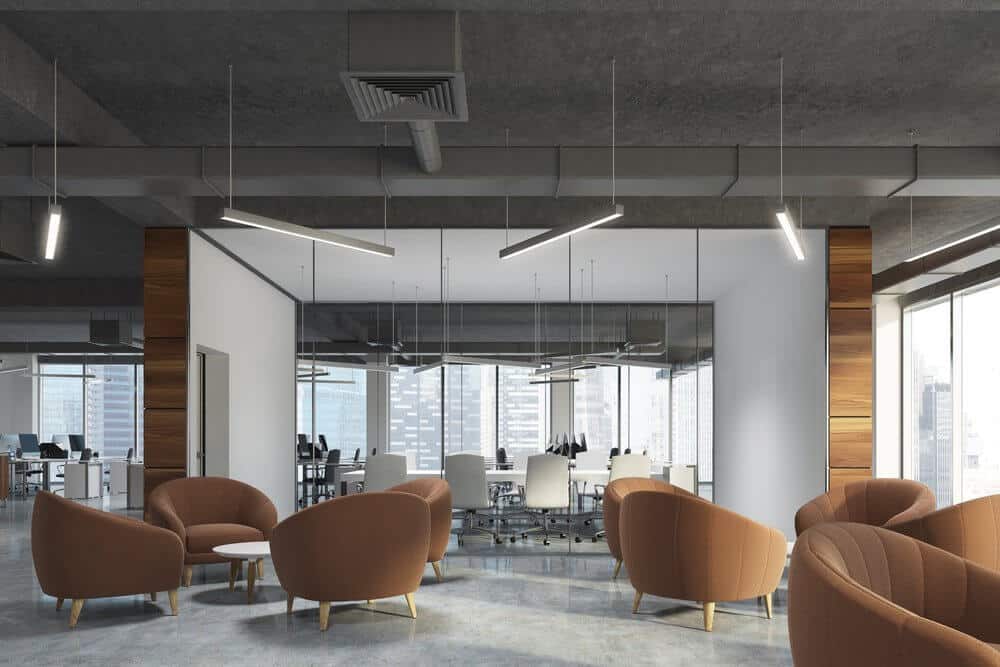What is an open office layout? Industries that thrive with open offices

Open office layouts, which initially rose to prominence in the 1960s, has drawn equal measures of praise and controversy since returning to vogue. Proponents praise the layout’s ability to break down silos and boost collaboration, while detractors claim it creates needless distraction and diminishes the sense of privacy some employees need to work effectively.
Of course, any major shakeup to the seating status quo is bound to draw a little criticism. If anything, well-meaning businesses embracing the open office trend without fully considering the ramifications (or the needs of their employees) may create more trouble than anything else with their revamped seating arrangement.
Industries that thrive with an open office layout
For industries that are primed to make the most of the design’s benefits, however, open offices have a lot to offer—and the following four industries are particularly well positioned to enjoy these strengths.
1. Graphic design and the visual arts

The suggestion that artists might flourish in an open office has less to do with the professional creative community’s establishment-shaking, trend-making reputation and more to do with the realities of ongoing visual work. Because visual projects tend to feature a healthy mix of individual effort and teamwork—and because those projects lend themselves to at-a-glance feedback sessions and quick bursts of collaboration—the removal of cubicle walls can create a connected environment that suits creative work.
The trick to helping visual design teams succeed in an open floor plan is making private flex space available to employees who do need it. Businesses on the fence about going open could hedge their bets by setting up a number of enclosed workspaces, thus giving employees the option to focus and work in solitude during crunch time. Making these spaces reservable via a web client or mobile app makes the sharing process even easier and opens the door to more creative seating solutions, hot desking being just one example.
2. Content marketing, media and news
The traits that make the open layout so effective for the visual fields make it equally convenient for newsrooms, content offices and other businesses where words are the primary product. Newsrooms in particular carried the open layout torch long after most businesses moved on in the 1980s, with “bullpen” designs fostering easier teamwork and collaboration throughout the open-plan recession and back into the current open office resurgence.
An open layout with reservable private space is an optimal mix in the writing arena as well as the visual, so hot desking and shared workspaces may even be appropriate given the content business tendency towards temporary projects and mixed teams. Again, as with visual arts, it’s important to provide quiet spaces for those who need to concentrate, and meeting rooms for those who need to collaborate or discuss sensitive information.
3. Software development

Yes, the software industry is one of the main places where the open plan trend sparked back to life, and yes, it’s also one of the places where it draws a fair amount of criticism. And while many of the tips presented above—reservable resources and a blend of private and open spaces, for example—fit just as well here, our suggestion for software companies comes from a twofold business perspective: software companies tend to scale quickly, and business real estate isn’t cheap.
Because of this, an open-plan layout can make it easier to fit more employees into the office without expensive moves or time-consuming cubicle reconfigurations. Throw in the fact that many software companies are built around the idea of small, fluid teams and you have an environment that is well-suited to the advantages of the open office. Analytical tools can further optimize your open office, giving facility managers deep insight into the factors that decide the success of their plans.
4. Contact centers
Like many digital-era entities, phone-based sales, service and support organizations—both third-party vendors and internal components of larger organizations—have seen rapid change. This is a shift that has as much to do with customer demand as it does with advancing technology. As a result, many organizations have moved away from the cubicle-based call center to a modern contact center model. A single rep may handle phones, write emails and chat online with customers from anywhere in today’s updated centers.
An open layout can foster a feeling of freedom, giving employees access to the tools they need whether they work at all-in-one desks or in a modified hot desk environment that swaps out phones for other forms of communication like video chat. As an added bonus, open designs also tend to be more space-efficient, making it easy to seat more temporary help for that big contract without squeezing employees uncomfortably close to one another. Closing sales and providing support may largely be an individual task, but the need for fluidity makes open plans a perfect match for any modernizing contact center.
You may also be interested in – 3 Industries with Unique Office Layout Demands.



